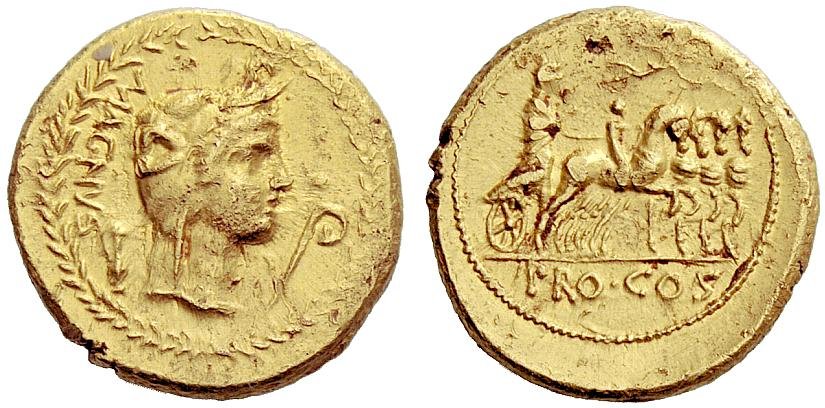Pompey (Spanish military mint), gold, aurei (Africa/Pompey driving quadriga) (RRC 402/1 Pompey - 72/71 BCE)
From SILVER
(Redirected from S 1643 - Spain (uncertain mint), gold, aurei (RRC 402 - 72/71 BCE))
72 BCE - 71 BCE Gold 27,768 kg
Description
| ObverseInscription or printing placed on the obverse.: | MAGNVS (Latin).Head of Africa right, wearing elephant's skin, on l., jug with handle to l., on r., lituus. All within wreath. |
| ReverseInscription or printing placed on the reverse.: | In exergue, PRO·COS (Latin).Pompey in triumphal quadriga r., holding branch in r. hand, on near horse, rider, above, flying Victory with wreath. |
Mint and issuing power
| MintIdentifies the place of manufacture or issue of a numismatic object.: | Pompey (Spanish military mint) | Ancient regionAncient region.: | Hispania Citerior | Modern countryModern country: Spain | AuthorityIdentifies the issuing power. The authority can be "pretended" when the name or the portrait of X is on the coin but he/she was not the issuing power. It can also be "uncertain" when there is no mention of X on the coin but he/she was the issuing power according to the historical sources: | Roman Republic, Sextus Pompeius Magnus Pius |
Chronology
| FromIdentifies the initial date in a range assigned in a numismatic context. | 72 BCE | toIdentifies the final date in a range assigned in a numismatic context.. | 71 BCE | PeriodTime period of the numismatic object.: Hellenistic 323-30 BC |
Physical description
| MetalThe physical material (usually metal) from which an object is made.: | Gold |
Median weightMedian of the weights of numismatic objects (in grams). in grams | 8.90 | DenominationTerm indicating the value of a numismatic object. Examples: tetradrachm, chalkous, denarius.: | aureus | StandardStandard.: |
Image

S1643 Pompey aureus.jpg [1]
References
| Die study referencePublication of the study: | Campana 2001c1Campana 2001c, Woytek 20152Woytek 2015 | ||
| Coin series referenceReference to coin series study: | RRC3RRC, n° 402 | ||
| Coin series web referenceCoin series web references: | |||
Obverse dies distribution
| FrequencyFrequency of specimen in distribution. ᵖ | Number of obversesNumber of obverse dies. ᵖ (o) | % (o) | Number of coinsNumber of coins. (n) | % (n) | Die nameName(s) of the die(s). |
| 1 | 3 | 75 | 3 | 60 | A, B, C |
| 2 | 1 | 25 | 2 | 40 | D |
| Total | 4 of 4 | 100 | 5 of 5 | 100 |
Reverse dies distribution
no distribution is available
Quantification
| Number of obversesNumber of obverse dies. ᵖ (o) | 4 | Number of singletons (o1)The number of singleton coins. ᵖ | 3 |
| Number of reverse diesNumber of reverse dies. (r) | 4 | Number of coinsNumber of coins. (n) | 5 |
| Coins per obverse dieNumber of coins per obverse die. (n/o) | 1.25 | Coins per reverse dieNumber of coins per reverse die. (n/r) | 1.25 |
| Reverse per obverse ratioRatio of obverse dies divided by reverse dies. (r/o) | 1 | Percentage of singletons (o1)number of coins (n) divided by the number of singletons (o1) ᵖ | 75 % |
| Original number of dies (O) (Carter 1983 formula)The estimation of the number of coins according to Carter 1983 ᵖ | 15.6 | Coins struck if 20,000 as average productivity per dieCoins made if the average productivity for obverses (according to Carter) is 20,000. ᵖ | 312,000 |
| Original number of dies (O) (Esty 2011 formula)The estimation of the number of coins according to the singleton formula in Esty 2011 ᵖ (O) | 20 | Survival rate if 20,000 as average productivity per dieSurvival rate if average productivity is 20,000. ᵖ | 0.00002 |
| Coverage (o = % of O) (Esty 1984 formula)Esty 1984 - coverage (% of O) ᵖ (o = % of O) | 40% | Die productivity if survival rate 1/2,000Average productivity if survival rate is 1/2,000. ᵖ | 641.03 |
| Weight of silver (in kg) if 20,000 coins per die (O = Carter formula)Carter 1983 * Median weight * 20000 (*10 if gold or electrum) ᵖ | 27,768 kg <br /> 27,768 kg | Die productivity if survival rate 1/5,000Average productivity if survival rate is 1/5,000. ᵖ | 1,602.56 |
Remarks
Certainly military
References
- ^ Campana, Alberto (2001), "Monete d’oro della Repubblica romana. VIII – Emissione di Gneo Pompeo Magno (71 a.C.)," Panorama Numismatico, 148, p. 20-24.
- ^ Woytek, Bernhard (2015), "The aureus of Pompey the Great revisited", in Peter van Alfen, Gilles Bransbourg and Michel Amandry (eds.), FIDES. Contributions to numismatics in honor of Richard B. Witschonke, New York, p. 403-425.
- ^ Crawford, Michael H. (1974), Roman Republican Coinage, Cambridge